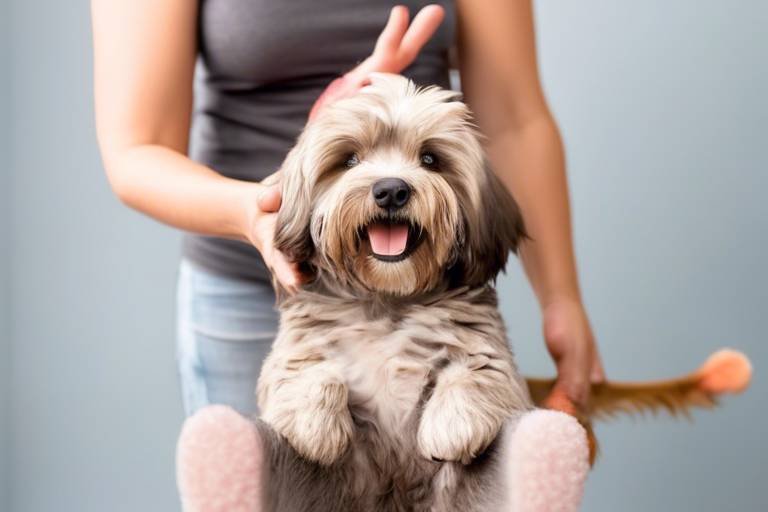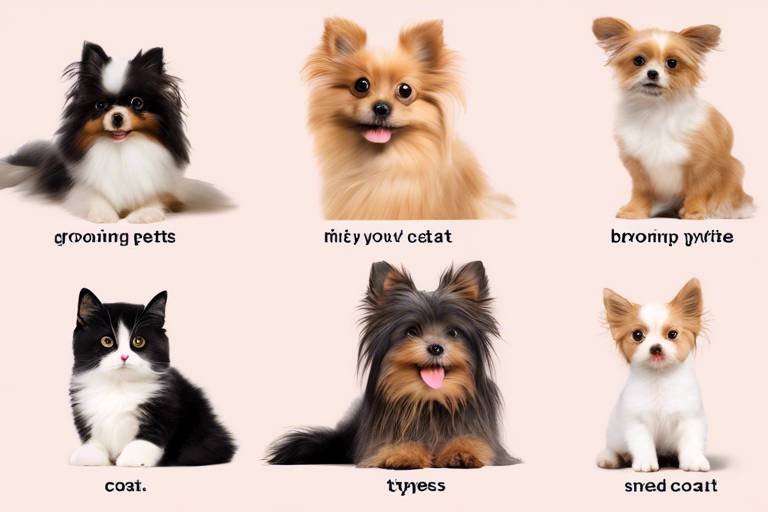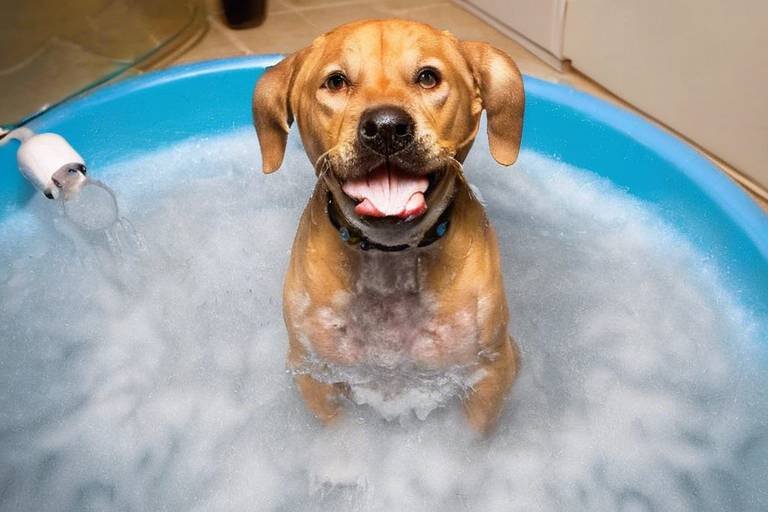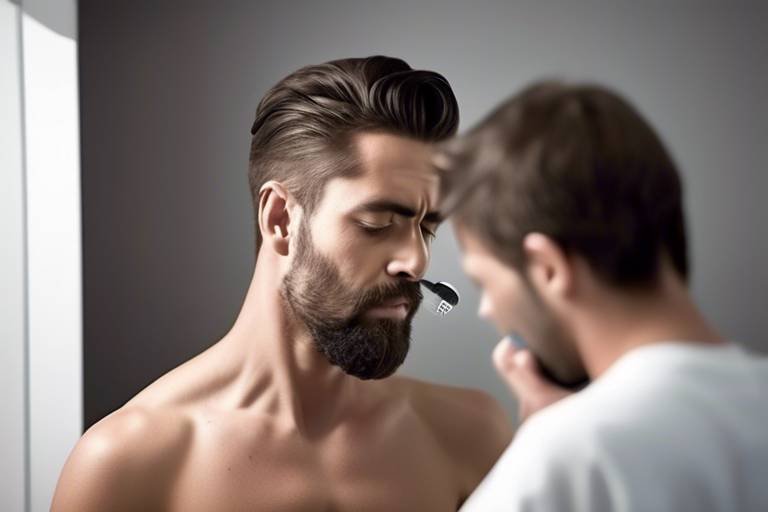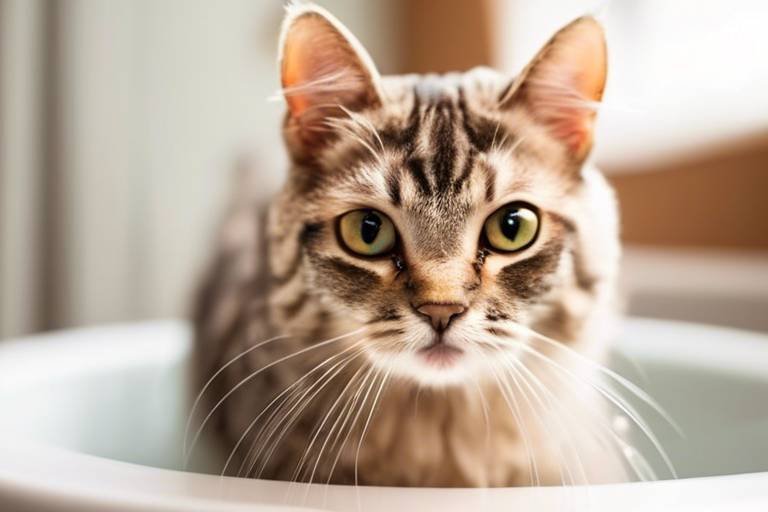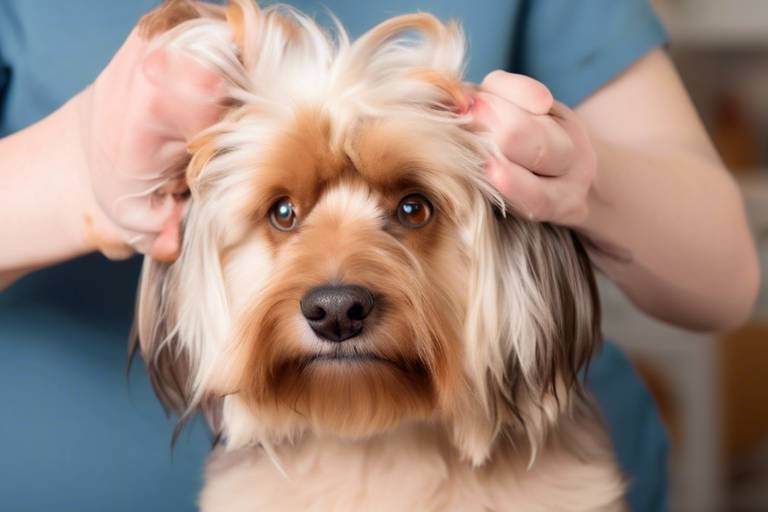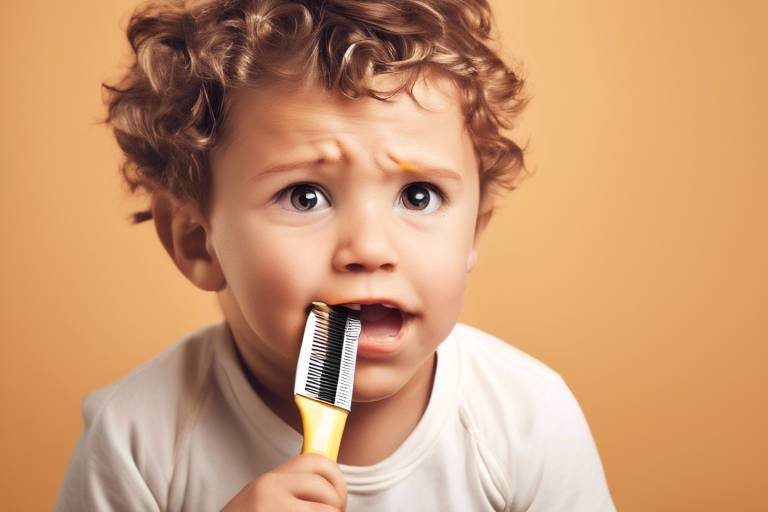The Benefits of Regular Grooming for Your Pet’s Mental Health
Have you ever noticed how your furry friend seems to light up during grooming sessions? It’s not just your imagination! Regular grooming is more than just a way to keep your pet looking sharp; it plays a vital role in their mental health. Just like we feel refreshed after a good shower or a haircut, pets experience a similar uplift in their mood through grooming. This article dives deep into how grooming can reduce anxiety, enhance happiness, and strengthen the bond between you and your beloved companion.
Pet anxiety can be a sneaky little monster that manifests in various ways. From destructive behavior like chewing on furniture to excessive barking or hiding, these signs are your pet's way of telling you something's not right. It's essential to recognize these behaviors early on. Grooming can be a fantastic tool to help address these issues. By incorporating regular grooming into your pet's routine, you can mitigate anxiety and create a sense of security that they might be missing in their lives.
Think of grooming as a soothing ritual for your pet. Just as a warm bath can calm our nerves after a long day, grooming sessions can serve the same purpose for our furry friends. The physical touch and attention they receive during grooming can create a comforting environment, making them feel safe and cherished. This calming effect is crucial in reducing stress levels and promoting a more relaxed demeanor.
The magic of physical touch during grooming cannot be overstated. When you brush or pet your animal, it releases endorphins—those feel-good hormones that elevate mood. This positive reinforcement helps build trust between you and your pet, reducing any anxiety or fear they may associate with grooming activities. It's like giving them a little dose of happiness every time you groom them!
Establishing a regular grooming routine is like setting a comforting rhythm in your pet's life. Pets thrive on predictability, and when grooming becomes a consistent part of their day, it offers them a sense of structure. Imagine how you feel when you have a set schedule; it brings a sense of calm and order. Similarly, your pet will find comfort in knowing when to expect their grooming sessions, making them feel more secure.
Using the right grooming tools can make all the difference in your pet's experience. Selecting brushes or combs that suit your pet's coat type is crucial. For instance, a soft brush might be perfect for a short-haired cat, while a slicker brush works wonders for a long-haired dog. Comfort is key; if your pet enjoys the grooming process, they’re more likely to associate it with positive feelings. This, in turn, enhances the overall experience for both of you!
Grooming sessions are not just about cleanliness; they also provide a fantastic opportunity for socialization. During these moments, pets interact with their owners and sometimes even other animals. This exposure can help reduce fear and anxiety, allowing pets to feel more comfortable in various environments. Think of it as a mini social gathering where your pet can learn to be more relaxed and confident.
Regular grooming isn’t just beneficial for your pet’s mental health; it also strengthens the bond between you and your furry friend. These grooming sessions are an opportunity for quality time, where both of you can enjoy each other's company. This shared experience fosters a deeper connection, leading to happier and more secure pets who trust you wholeheartedly.
Did you know that grooming can double as a training opportunity? It’s true! Regular grooming teaches pets to remain calm and cooperative, which is essential for their overall behavior. By reinforcing positive behavior during grooming, you make future sessions more manageable and less stressful for both of you. It’s like a two-for-one deal: you get a well-groomed pet and a well-behaved one!
Another crucial aspect of regular grooming is that it allows you to spot potential health issues early. While grooming your pet, you can check for skin irritations, lumps, or any unusual changes in their body that might indicate a health problem. Early detection can lead to timely veterinary care, which is vital for your pet's overall well-being. So, grooming isn’t just about aesthetics; it’s about keeping your pet healthy, too!
- How often should I groom my pet? - It depends on the breed and coat type. Long-haired pets may need grooming several times a week, while short-haired pets may only need it once a month.
- Can grooming help with shedding? - Yes! Regular grooming can help manage shedding by removing loose fur and dander.
- What tools do I need for grooming? - Basic tools include brushes, combs, scissors, and nail clippers. Choose tools that are suitable for your pet's coat type.

Understanding Pet Anxiety
Pet anxiety is a significant concern for many pet owners, and it can manifest in various ways that may leave you puzzled. Have you ever come home to find your beloved dog has chewed up your favorite shoes or your cat has taken to hiding under the bed? These behaviors are often signs of anxiety that can stem from multiple sources, including changes in their environment, loud noises, or even separation from their owners. It's essential to recognize these signs early on, as they can lead to more severe behavioral issues if left unaddressed.
Common symptoms of pet anxiety include:
- Destructive behavior: Chewing furniture or scratching doors can indicate a pet's distress.
- Excessive barking or meowing: Vocalizing more than usual can be a cry for help.
- Hiding or withdrawal: If your pet suddenly becomes reclusive, it may be feeling overwhelmed.
- Changes in eating habits: A stressed pet may lose interest in food or overeat as a coping mechanism.
Understanding these signs is crucial for pet owners. By identifying the root causes of anxiety, you can take proactive steps to alleviate your pet's stress. For instance, environmental factors such as moving to a new home or introducing a new family member can create anxiety. Additionally, loud noises like thunderstorms or fireworks can trigger fear responses in pets. Recognizing these triggers allows you to implement strategies that can help your furry friend feel more secure and relaxed.
Moreover, it's important to remember that each pet is unique. What causes anxiety in one pet may not affect another in the same way. Therefore, maintaining a close relationship with your pet and observing their behavior can provide valuable insights into their emotional state. This understanding can guide you in developing a tailored approach to support your pet's mental health and well-being.
In summary, understanding pet anxiety is the first step in addressing it effectively. By being vigilant about the signs and considering the potential triggers, you can create a more supportive environment for your pet. This proactive approach not only helps in reducing their anxiety but also strengthens the bond between you and your furry companion.

The Role of Grooming in Stress Reduction
When it comes to our furry friends, grooming is not just about keeping them looking sharp; it plays a crucial role in their emotional well-being. Imagine how a soothing massage can help you unwind after a long day—this is exactly what grooming does for pets. The act of grooming provides a calming ritual that can significantly alleviate stress and anxiety. During these moments, pets receive not only physical care but also emotional support, which can be incredibly beneficial for their mental health.
One of the most significant aspects of grooming is the physical touch involved. When you brush or bathe your pet, you're not just cleaning their fur; you're also engaging in a form of interaction that releases endogenous opioids in their brain. These natural chemicals act as mood elevators, helping your pet feel more relaxed and content. Think of it as their version of a spa day! This is especially important for pets that may feel anxious or fearful in certain situations, as the familiar routine of grooming can provide a sense of security.
Creating a grooming routine can be a game changer. Just like humans thrive on structure, pets do too. Establishing a regular schedule for grooming can provide your pet with a sense of predictability, which is essential for reducing anxiety. They’ll come to look forward to these sessions, knowing that it’s a time for bonding and relaxation. For example, you might choose to groom your pet every Saturday morning. This consistency not only helps your pet feel more secure but also strengthens the bond you share.
Furthermore, the choice of grooming tools can significantly enhance your pet's experience. Using the right brushes or combs for their specific coat type can make a world of difference. For instance, a gentle slicker brush is perfect for long-haired breeds, while a rubber grooming mitt can be soothing for short-haired pets. By ensuring that the tools you use are comfortable for your pet, you can make grooming a more enjoyable process, thereby reducing any stress associated with it.
Lastly, grooming sessions often incorporate socialization, which is another key factor in stress reduction. When you groom your pet, it’s not just a solo activity; it often involves interaction with you and sometimes even other pets. This exposure helps them become accustomed to various environments and situations, reducing their fear and anxiety over time. Just think about how much more confident you feel when you’re surrounded by supportive friends—your pet feels the same way!
- How often should I groom my pet? It depends on the breed and coat type. Long-haired breeds may require grooming several times a week, while short-haired pets might only need it once a month.
- Can grooming help with my pet's anxiety? Yes! Regular grooming can significantly reduce anxiety by providing a calming routine and promoting physical touch.
- What tools should I use for grooming? Choose tools that are appropriate for your pet's coat type. Brushes, combs, and grooming gloves can all serve different purposes.
- Is grooming a good bonding activity? Absolutely! Grooming provides quality time for you and your pet, strengthening your bond and enhancing their emotional well-being.
Physical Touch and Its Benefits
When it comes to our furry companions, physical touch is a powerful tool that can significantly improve their mental health. Just think about it: how do you feel after a long, stressful day when someone gives you a warm hug or a gentle pat on the back? That same comfort can be translated to our pets during grooming sessions. The act of grooming is not just about keeping your pet looking sharp; it's an opportunity to engage in a soothing ritual that can have profound effects on their emotional well-being.
During grooming, the gentle strokes of a brush or the rhythmic motion of a comb can release endorphins in your pet's body. These natural chemicals are known for their mood-lifting properties, which can help alleviate feelings of anxiety and stress. Imagine your pet's worries melting away with every stroke of the brush! This physical connection fosters a sense of security and trust, making grooming a positive experience rather than a chore.
Additionally, the bonding that happens during grooming sessions is invaluable. It's a time when you can focus solely on your pet, reinforcing your relationship and enhancing their feelings of safety. Pets thrive on attention, and when they receive it through physical touch, they feel valued and loved. This emotional boost can lead to a happier, more confident pet who is less likely to exhibit anxiety-driven behaviors.
Moreover, grooming can serve as a preventative measure for behavioral issues. When pets associate grooming with positive experiences, they are more likely to remain calm and cooperative in other situations. This creates a cycle of trust and reassurance, allowing them to adapt better to new environments and experiences. So, the next time you brush your pet, remember that you are not just making them look good; you are also nurturing their mental health and emotional stability.
In summary, the benefits of physical touch during grooming extend far beyond aesthetics. It is a vital part of your pet's overall well-being, providing them with the comfort and love they need to thrive. So, grab that brush, and let the bonding begin!
- How often should I groom my pet? The frequency of grooming depends on your pet's breed, coat type, and lifestyle. Generally, long-haired breeds may require grooming every few days, while short-haired breeds can be groomed weekly.
- What tools do I need for grooming? Essential grooming tools include brushes, combs, nail clippers, and shampoo. Choosing the right tools for your pet's coat type is crucial for a comfortable grooming experience.
- Can grooming help with my pet's anxiety? Yes! Regular grooming can significantly reduce anxiety by providing physical touch, which releases endorphins and fosters a sense of security.
- What should I do if my pet resists grooming? Start slowly and associate grooming with positive experiences. Use treats and gentle encouragement to help them feel more comfortable.
Creating a Routine
Establishing a regular grooming routine for your pet is not just about keeping them looking their best; it's about creating a sense of stability and comfort in their lives. Just like humans thrive on routine, pets also find solace in predictability. Imagine your pet's joy when they know that every Saturday morning is dedicated to their grooming session. It becomes a special time when they can enjoy your undivided attention, reinforcing their sense of security.
When you set a grooming schedule, you’re not only helping your pet look good, but you’re also contributing to their mental well-being. Consistency is key! Whether it’s a quick brush, a bath, or a nail trim, having a designated time for grooming can help reduce anxiety. Pets often feel more at ease when they know what to expect. Think of it as a ritual that both you and your furry friend can look forward to. This predictability can be incredibly soothing for them, much like a child feels secure in knowing that bedtime comes after storytime.
To make the most of your grooming routine, consider the following tips:
- Choose a specific day and time: Consistency is crucial. Try to stick to the same day and time each week.
- Keep it short and sweet: Start with shorter sessions to help your pet acclimate, gradually increasing the duration as they become more comfortable.
- Incorporate play: End each grooming session with a playtime reward. This reinforces positive behavior and makes grooming a fun experience.
By turning grooming into a regular affair, you’re not just maintaining their coat; you’re also nurturing your bond. This routine can become a cherished part of your relationship, fostering trust and affection. As your pet learns to associate grooming with love and care, they will likely become more relaxed and cooperative during these sessions.
In summary, creating a grooming routine is a win-win for both you and your pet. It provides structure, enhances their mental health, and strengthens the emotional bond you share. So, grab those grooming tools and make it a delightful habit that you both can enjoy!
Q1: How often should I groom my pet?
A: The frequency of grooming depends on your pet's breed and coat type. Long-haired breeds may require grooming several times a week, while short-haired pets may only need it once a month.
Q2: What if my pet doesn't like grooming?
A: Start with short sessions and gradually increase the time as they become more comfortable. Use treats and praise to create positive associations with grooming.
Q3: Can grooming help with shedding?
A: Yes! Regular grooming can help reduce shedding by removing loose fur and dander, keeping your home cleaner and your pet healthier.
Q4: Should I take my pet to a professional groomer?
A: If you're unsure about grooming techniques or if your pet has specific needs, visiting a professional groomer can be beneficial. They can also provide valuable advice on maintaining your pet's coat at home.
Choosing the Right Tools
When it comes to grooming your beloved pet, selecting the right tools is paramount. Just like a painter needs the right brushes to create a masterpiece, you need the appropriate grooming tools to ensure your pet's experience is both comfortable and effective. Imagine trying to comb through a tangled mess with a tool that isn't designed for the job—it can be frustrating for both you and your furry friend!
Start by considering your pet's specific coat type. For instance, long-haired breeds may require a slicker brush to detangle knots, while short-haired pets might benefit from a bristle brush that removes loose hair and distributes natural oils. Here’s a quick breakdown of common coat types and the best tools to use:
| Coat Type | Recommended Tools |
|---|---|
| Long Hair | Slicker Brush, Wide-Toothed Comb |
| Short Hair | Bristle Brush, Rubber Grooming Mitt |
| Curly Hair | Pin Brush, Dematting Tool |
| Double Coat | Undercoat Rake, De-shedding Tool |
Additionally, consider your pet’s comfort during grooming. A tool that feels good in your hand can make a world of difference. Look for ergonomic designs that reduce strain on your wrists and hands, especially if you have a larger pet that requires more effort. It's also essential to choose tools with soft bristles or rounded edges to prevent any discomfort during the grooming process.
Another factor to consider is the frequency of grooming. Some pets may need daily brushing, while others might only require it weekly. Having the right tools on hand can make these sessions feel less like a chore and more like a bonding experience. Remember, grooming is not just about keeping your pet looking good; it's about ensuring their overall health and happiness.
Lastly, don’t forget about the importance of cleaning and maintaining your grooming tools. Regularly removing hair and debris from brushes and combs will keep them effective and hygienic. A well-maintained tool not only performs better but also contributes to a more pleasant grooming experience for your pet.
Socialization Through Grooming
Grooming is not just about keeping your pet looking good; it serves as a vital avenue for enhancing their social skills. When you engage in regular grooming sessions, you create opportunities for your pet to interact with you, other pets, and even new environments. This interaction is crucial for developing their socialization skills, which can significantly reduce anxiety and fear in various situations.
Think about it: every time you brush your furry friend, you're not just removing tangles and dirt; you're also providing a chance for them to experience gentle touch and human interaction. This physical contact can be incredibly reassuring, especially for pets that may be shy or fearful. The more they are exposed to positive experiences during grooming, the more confident they become in social settings.
Moreover, if you take your pet to a professional groomer, they will encounter other animals and humans, which can further enhance their social skills. These experiences can help pets learn how to behave around other animals, making them less anxious in parks or during playdates. The combination of the familiar routine of grooming and the new experiences it brings can create a balanced emotional state for your pet.
Here are some ways grooming promotes socialization:
- Positive Reinforcement: Grooming can be paired with treats and praise, reinforcing good behavior and making social interactions more enjoyable.
- Exposure to Different Environments: Visiting various grooming locations exposes pets to new sights, sounds, and smells, all of which are essential for their social development.
- Meeting New People and Pets: Grooming sessions, especially at pet salons, allow your pet to meet other animals and their owners, helping them learn to interact positively.
In essence, grooming is a multifaceted activity that goes beyond mere hygiene. It is a powerful tool for building your pet's confidence and social skills, ultimately leading to a happier and more well-adjusted companion. So, the next time you pick up that brush or head to the groomer, remember that you're not just making your pet look good; you're also helping them become a more social and confident member of your family.
Q: How often should I groom my pet?
A: The frequency of grooming depends on your pet's breed and coat type. Long-haired breeds may require grooming several times a week, while short-haired breeds may need grooming less frequently.
Q: Can grooming help with my pet's anxiety?
A: Yes! Regular grooming can provide a calming routine and physical touch, both of which can help reduce anxiety in pets.
Q: What tools should I use for grooming?
A: The right tools depend on your pet's coat type. Brushes, combs, and grooming gloves are popular options. Always choose tools that are comfortable for your pet.
Q: Is it better to groom my pet at home or take them to a professional?
A: Both options have their benefits. Grooming at home can strengthen your bond, while professional groomers can provide specialized care and socialization opportunities.

Improving Bonding with Your Pet
Regular grooming isn't just about keeping your pet looking fabulous; it's a golden opportunity to enhance the bond between you and your furry friend. Imagine this: every time you pick up a brush or a comb, you’re not just removing loose fur; you’re also creating a moment where trust and affection can blossom. The act of grooming becomes a shared experience, a ritual that can transform your relationship from merely owner and pet to true companions. Through this process, pets learn to associate your presence with comfort, care, and love.
During grooming sessions, the atmosphere is often calm and focused, allowing both you and your pet to engage in meaningful interaction. This time spent together can be incredibly beneficial, especially if you incorporate gentle talking, soft petting, and even treats. Think of it as a spa day for your pet, where they receive not just physical care but emotional support as well. As you brush away tangles and dirt, you’re also brushing away stress and anxiety, creating a safe haven for your pet.
Moreover, grooming can serve as a training opportunity. It’s a chance to teach your pet how to stay still, respond to commands, and even enjoy the process. When your pet learns to cooperate during grooming, it fosters a sense of accomplishment for both of you. This mutual understanding can lead to a stronger bond, as your pet starts to trust you more with each session. Remember, every time you groom your pet, you’re reinforcing the idea that they are safe and loved in your presence.
To further enhance this bonding experience, consider establishing a grooming routine. Pets thrive on predictability, and when grooming becomes a regular part of their schedule, they begin to look forward to it. You might even notice them getting excited as you prepare the grooming tools! This anticipation is a sign of their growing trust and affection towards you.
In addition to the emotional benefits, grooming also allows you to check for health issues that might otherwise go unnoticed. While you’re bonding and grooming, you have the perfect opportunity to inspect your pet’s skin, fur, and overall condition. This proactive approach not only keeps your pet looking great but also ensures their health is monitored closely. A strong bond is built on trust, and when your pet knows you’re looking out for their well-being, that bond deepens even further.
In conclusion, grooming is much more than a chore; it’s a vital part of nurturing your relationship with your pet. The time spent grooming fosters a deeper connection, enhances trust, and creates a safe space where both you and your pet can thrive together. So next time you reach for that brush, remember: you’re not just grooming; you’re building a lifelong bond filled with love and companionship.
- How often should I groom my pet? It depends on the breed and coat type, but generally, regular grooming every 4 to 6 weeks is advisable.
- Can grooming help with my pet's anxiety? Absolutely! Regular grooming can soothe anxiety and create a calming routine for your pet.
- What tools do I need for grooming? Basic grooming tools include brushes, combs, nail clippers, and pet-safe shampoos.
- Is grooming a good bonding experience? Yes! Grooming fosters trust and enhances the bond between you and your pet.
Grooming as a Training Opportunity
Grooming your pet isn't just about keeping them looking fabulous; it's also a fantastic training opportunity. Think of grooming sessions as mini-training camps where your furry friend can learn to be calm and cooperative. When you introduce grooming as a regular activity, you're not only helping them maintain their hygiene but also teaching them essential behaviors that can make future grooming easier. It’s like going to the gym for your pet—every session builds their strength and resilience.
During grooming, you can incorporate basic commands such as "sit," "stay," or even "lie down." This not only reinforces their training but also creates a structured environment where your pet knows what to expect. Imagine your dog patiently sitting while you brush them, their tail wagging in delight. This is a clear sign that they are learning to associate grooming with positive experiences. The key is to keep it fun and rewarding!
Consider using treats and praise to encourage good behavior during grooming. For instance, if your cat allows you to brush them without squirming, reward them with a tasty treat. This positive reinforcement builds a connection between good behavior and rewards, making your pet more likely to remain calm in future grooming sessions. Just like we appreciate a good compliment, pets thrive on positive feedback!
Moreover, grooming can help desensitize pets to being handled. Many pets may initially resist grooming because they’re not used to being touched in certain areas. By gradually introducing them to different grooming tools and techniques, you are helping them become more comfortable with handling. This is especially beneficial for pets who may need medical attention in the future; a pet that is accustomed to being touched and groomed will be much easier to handle during vet visits.
So, the next time you pick up that brush or clippers, remember: you're not just grooming; you're training, bonding, and building a stronger relationship with your pet. The grooming process can be a beautiful dance of trust and cooperation, leading to a happier, healthier, and more well-adjusted pet.
- How often should I groom my pet? - It depends on the breed and coat type. Long-haired breeds may require grooming several times a week, while short-haired breeds might only need it every few weeks.
- Can grooming help with my pet's anxiety? - Absolutely! Regular grooming can provide comfort and security, helping to alleviate anxiety.
- What tools do I need for grooming? - The tools vary based on your pet's coat type, but common items include brushes, combs, and nail clippers.
- Is it necessary to take my pet to a professional groomer? - While you can groom at home, professional groomers can be beneficial for specific breeds or if you're unsure about grooming techniques.
Recognizing Health Issues Early
Regular grooming is not just about keeping your pet looking fabulous; it's a vital part of their overall health care routine. During grooming sessions, you have the opportunity to closely examine your pet’s body, which can help you spot potential health issues early. Think of it as your personal detective work—you're not just brushing fur; you're investigating the well-being of your furry friend. For instance, while brushing, you might notice unusual lumps, bumps, or skin irritations that could indicate underlying health problems.
It's essential to be aware of some common health issues that can be detected during grooming. Here are a few signs to keep an eye out for:
- Skin Irritations: Look for redness, rashes, or excessive scratching, which could suggest allergies or infections.
- Lumps and Bumps: Any new growths should be monitored closely, as they may require veterinary evaluation.
- Ear Health: Check for odor, redness, or discharge in your pet's ears, which can indicate infections.
- Dental Issues: While grooming, you can also check your pet's mouth for bad breath, tartar buildup, or swollen gums.
By establishing a routine grooming schedule, you can create a habit of checking your pet thoroughly. This not only helps in identifying potential issues but also fosters a deeper bond between you and your pet. Imagine how comforting it is for them to know that you are looking out for their health while pampering them at the same time!
Moreover, keeping a record of your pet's grooming sessions can be beneficial. You might want to consider maintaining a simple table like the one below to track any observations:
| Date | Grooming Observations | Actions Taken |
|---|---|---|
| 2023-10-01 | Noticed a small lump on the back | Scheduled a vet appointment |
| 2023-10-15 | Skin irritation on the belly | Applied hypoallergenic cream |
In conclusion, regular grooming sessions are a fantastic way to not only keep your pet looking their best but also to ensure their health is in check. By paying attention to the little details during grooming, you can catch potential health issues early, leading to timely intervention and a happier, healthier pet.
Q: How often should I groom my pet?
A: The frequency of grooming depends on the breed and coat type of your pet. Long-haired breeds may require grooming several times a week, while short-haired pets might only need it once a month.
Q: What should I do if I find a lump on my pet?
A: If you discover a lump, it's best to consult with your veterinarian for a proper assessment. Early detection can be crucial.
Q: Can grooming help with my pet's anxiety?
A: Yes! Regular grooming can provide comfort and security for pets, helping to reduce anxiety levels over time.
Q: What tools do I need for grooming?
A: Basic grooming tools include a brush, comb, nail clippers, and shampoo. Make sure to choose tools that are appropriate for your pet’s coat type.
Frequently Asked Questions
- How often should I groom my pet?
Grooming frequency can vary depending on your pet's breed and coat type. Generally, long-haired pets may need grooming every few days, while short-haired pets can be groomed weekly. Establishing a routine helps your pet feel secure and comfortable.
- Can grooming help reduce my pet's anxiety?
Absolutely! Regular grooming can act as a calming ritual, providing physical touch and attention that helps alleviate stress. The soothing experience of grooming releases endorphins, which can significantly improve your pet's mood and reduce anxiety.
- What tools should I use for grooming?
The right grooming tools depend on your pet's coat type. For instance, slicker brushes work well for long-haired pets, while rubber brushes are great for short-haired breeds. Always choose tools that make the grooming experience comfortable and enjoyable for your furry friend.
- How can grooming improve my bond with my pet?
Grooming is a fantastic way to spend quality time with your pet. This shared experience strengthens your relationship, making your pet feel more secure and loved. Plus, the physical closeness during grooming sessions fosters trust and affection.
- What signs of health issues should I look for while grooming?
During grooming, keep an eye out for any unusual lumps, skin irritations, or changes in your pet's coat condition. Early detection of these issues can lead to timely veterinary care, ensuring your pet stays healthy and happy.
- Can grooming help with my pet's socialization?
Yes! Grooming sessions often involve interaction with humans and other pets, which promotes socialization. This exposure can help your pet become more comfortable in various environments, reducing fear and anxiety in new situations.



